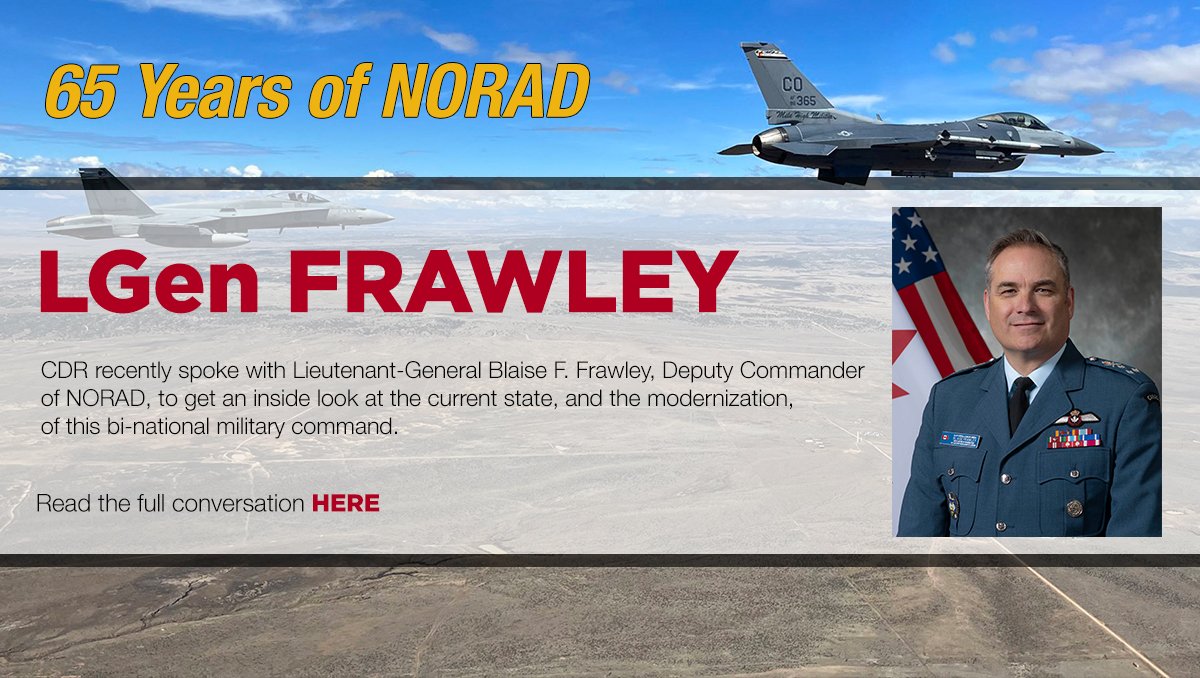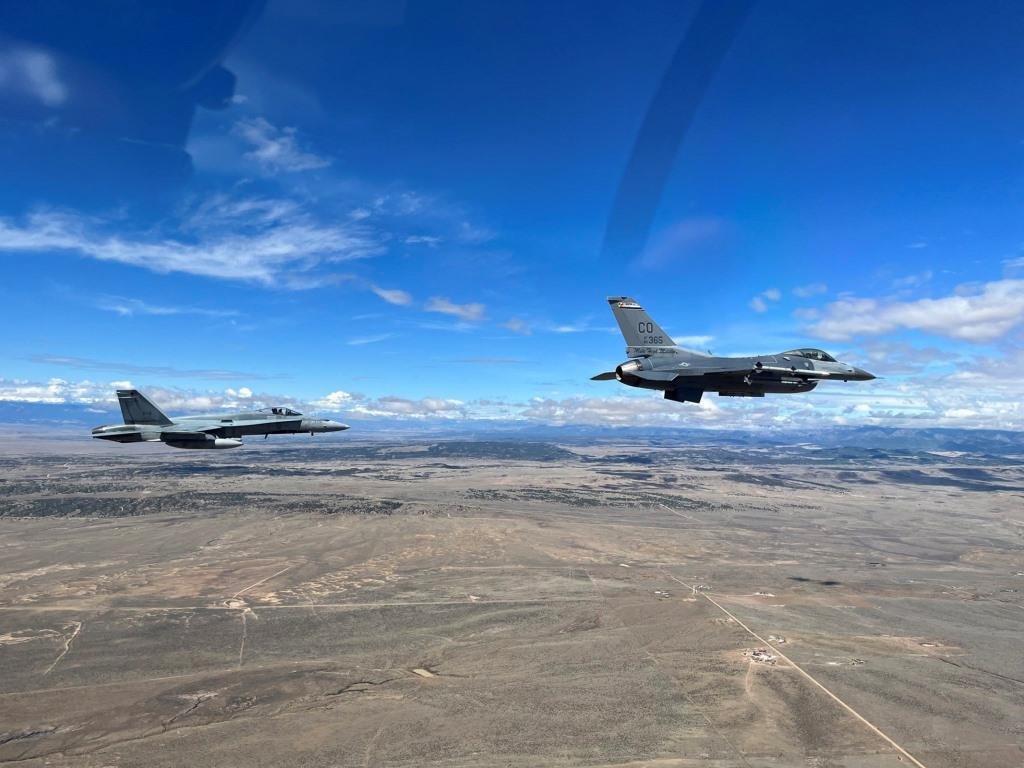CDR NEXT QUESTION - LGen Blaise Frawley, Deputy Commander NORAD
BY JAMES CARELESS
65 Years of NORAD
CDR recently spoke with Lieutenant-General Blaise F. Frawley to get an inside look at the current state, and the modernization, of this bi-national military command. Here is our report.
 $38.6 billion: That’s how much Canada has allocated to help modernize North American Aerospace Defense Command (NORAD) over the next two decades. NORAD is the bi-national military command responsible for aerospace warning, aerospace control, and maritime warning for Canada and the United States. It is the cornerstone of Canada’s defence relationship with the United States and provides both countries with greater continental security than could be achieved individually.
$38.6 billion: That’s how much Canada has allocated to help modernize North American Aerospace Defense Command (NORAD) over the next two decades. NORAD is the bi-national military command responsible for aerospace warning, aerospace control, and maritime warning for Canada and the United States. It is the cornerstone of Canada’s defence relationship with the United States and provides both countries with greater continental security than could be achieved individually.
“As autocratic regimes threaten the rules-based international order, as the security and defence impacts of climate change increase, and as our competitors develop new technologies like hypersonic weapons, there is a pressing need to modernize the North American Aerospace Defense Command (NORAD) that has kept us safe for over 60 years,” said Anita Anand, Minister of National Defence, when this investment was announced in June 2022. “The plan brought forward will deliver modern, state-of-the-art equipment for our Canadian Armed Forces, who put their lives on the line every single day to ensure the security and sovereignty of our country, and it will protect Canadians for generations.”
But what does this investment actually entail, and what does it mean to the Canadian Armed Forces (CAF) and to Canada’s defence industry? To find out, CDR spoke with Lieutenant-General Blaise F. Frawley, Deputy Commander of NORAD.
Lieutenant-General Frawley joined the CAF in 1985, and upon completion of pilot training was posted to 425 Squadron at 3 Wing Bagotville, Quebec. His flying experience includes two operational tours on 425 Squadron, an F/A-18 exchange tour with the United States Marine Corps in El Toro, California, and three instructional tours on 410 Squadron at 4 Wing Cold Lake, Alberta.
LGen Frawley has flown combat missions over the Federal Republic of Yugoslavia and Kosovo in support of Operation Allied Force and was assigned as the Executive Officer of the Task Force Aviano National Command Element at Vicenza, Italy, and the Air Mobility Division Deputy Director, 609th Combined Air and Space Operations Centre at Al Udeid Airbase, Qatar.
LGen Frawley's command tours include Commanding Officer of 410 Tactical Fighter / Operational Training Squadron in Cold Lake, Commander of both 17 Wing and the Air Force Training Centre in Winnipeg, and selection as Combined Force Air Component Commander for Exercise Rim of the Pacific 2016.
During his many operational and instructional flying tours, LGen Frawley has accumulated over 3,000 hours on the CF-18 Hornet. He is a graduate of the Fighter Weapons Instructor and the Fighter Electronic Warfare Advanced Radar courses.
In May 2023, LGen Frawley was promoted to his current rank, and in June 2023, was appointed as the NORAD Deputy Commander.
CDR: General Frawley, thank you for speaking with us today. Your responsibility as Deputy Commander NORAD spans not only North America but the globe, so I’d like to ask you to provide a snapshot assessment of the global security situation today, and why NORAD is more important than ever.
LGen Frawley: We are in one of the most dynamic and strategically challenging times I have seen in my career. For the first time in history, the West has two strategic peers, both nuclear armed, and a third actor – North Korea – who continues to launch ballistic missiles and use nuclear rhetoric at a rate we have never seen previously. We are also under attack every single day in the cyber and information spaces, with attacks targeting our critical infrastructure and utility systems. These authoritarian states, and others, seek to sow disorder and discontent online in Western liberal democracies.
These strategic competitors have been spending the past 20 years developing advanced, long-range, and faster weapons technologies designed to hold us at risk. That is where NORAD comes in, to mitigate these risks in the aerospace domain. To bolster NORAD’s capabilities to address these modern threats, both Canada and the U.S. have committed funding to NORAD modernization, with a recent visible piece being last year’s announcement by the Government of Canada committing $38.6B on an accrual basis over 20 years. The modernization effort includes a series of new and enhanced capabilities to ensure NORAD can detect, deter, deny, and defend North America against aerospace threats well into the future. Initiatives such as over-the-horizon radar, marked in both the Canadian and U.S. NORAD modernization efforts, will provide better domain awareness for the earliest detection of air- and sea-launched cruise missiles, from the Arctic all the way down to include the Atlantic and Pacific approaches to North America.
IMPORTANCE OF THE ARCTIC
CDR: Last November your predecessor, LGen Pelletier, spoke at the Best Defence Conference in London, Ontario and informed attendees about the importance of the Arctic. Can you explain to our readers why the Arctic is so important and some of the major challenges we face in Canada’s far North?
LGen Frawley: The Arctic, which has evolved from a cold, dark, remote, isolated, and disconnected region, is now an increasingly consequential and strategically important region. Particularly with the current rate of climate change, Russia and China’s interest in the Arctic has significantly piqued and they have clearly made long-term investments in the region. The easiest path to attack North America is through the Arctic, and our strategic competitors know it.
NEW THREATS
CDR: Beyond Chinese spy balloons, what sort of new threats is NORAD preparing for?
LGen Frawley: Today’s threats are integrated, 360-degrees from all vectors, all domains, and from myriad of sources, both symmetric and asymmetric. NORAD has had to evolve – and must continue to evolve – to address emerging aerospace threats with USNORTHCOM, Canadian Joint Operations Command (CJOC), including its cyber forces, CYBERCOM, SPACECOM, and multiple other interagency organizations in Canada and the United States to address the integrated nature of these all-domain threats. Our headquarters in Colorado Springs has over 100 Liaison Officers from over 25 organizations.
When we talk about defence of North America, it is about having a layered defence, which does not start in our homelands, it starts abroad. We do not want to be shooting down cruise missiles over Washington D.C. or Ottawa, that’s too late. We need to be engaging well before and creating opportunities through our partners by sharing information and through all levers of influence.
65TH ANNIVERSARY 
CDR: On May 12th, 2023, NORAD celebrated its 65th anniversary. Can you please tell us what was included as part of this anniversary.
LGen Frawley: NORAD’s 65th anniversary commemorated NORAD’s key accomplishments and highlighted the enduring strength of its mission in the defence of North America. Throughout these years, NORAD has safeguarded Canada and the U.S. from threats in the air domain and, since 2006, in the maritime domain. We have always leveraged our most distinct advantage: our bi-national partnership between Canada and the U.S. The anniversary celebration itself consisted of a formal ceremony, including a fly over.
I am honoured to take on the role of NORAD Deputy Commander, leading one of the most dedicated, talented, and professional teams of Canadians and Americans contributing to the security of our two great nations. This is a humbling time in my career, knowing that woven into this new mantle of leadership is the experience and wisdom of the previous 26 NORAD Deputies.
CDR: What is the current state of NORAD’s defence systems?
LGen Frawley: NORAD deploys a wide array of platforms, sensors and capabilities from aircraft to a network of radar systems to effectively execute the missions of aerospace warning, aerospace control and maritime warning. This effort is conducted in an ever-changing environment where our strategic competitors, such as Russia and the People’s Republic of China, continue to challenge the rules-based international order that has provided global stability and prosperity for more than 70 years. NORAD’s ability to do its job remains critical to the defence of Canada and the United States. That said, our defence capabilities rely on decades-old infrastructure and equipment that can, at times, lag behind the technologies fielded by our strategic competitors and potential adversaries. We have identified gaps within our networks that affect our ability to sense potential threats beyond the horizon, and our nations’ government are committed to addressing that critical piece in our defence systems.
MODERNIZATION
CDR: Why is it time to modernize them? What new threats do you have to deal with?
LGen Frawley: The North Warning System in Canada and the United States has provided early warning as part of our North American defence apparatus for roughly 35 years now. While we can maintain and sustain those systems going forward, it doesn’t change the fact that our strategic competitors are fielding air- and sea-based technologies that can deploy airborne, long-range strike capabilities such as advanced cruise missiles and hypersonic systems that can be used to attack Canada and the United States from outside the detection range and axis of our legacy sensors and at speeds never seen before. Our strategic competitors, namely the People’s Republic of China and Russia, continue to expand their investments and activities in the Arctic region. To address this rapidly evolving threat environment, including in the North and through our Northern approaches, we must move faster to improve our ability to detect, deter, deny and defend North America.
CDR: When this project is done, how will the modernized NORAD compare to the old one?
LGen Frawley: The new capabilities as a result of modernization efforts, such as over-the-horizon radar and infrastructure enhancements, will allow NORAD assets to more effectively monitor, detect and respond to threats earlier, giving leadership at all levels the necessary, value-added time to make decisions. We accomplish this by adhering to our three core missions of aerospace warning, aerospace control and maritime warning, but also by incorporating next-generation capabilities with advanced systems that generate the best all-domain awareness solutions. Our ability to upgrade and match advanced technologies with those of our strategic competitors through additional investment in research and development will be a factor in our ability to effectively alter their intent.
CDR: Thank you, General.
James Careless is CDR’s Ottawa Bureau Chief

